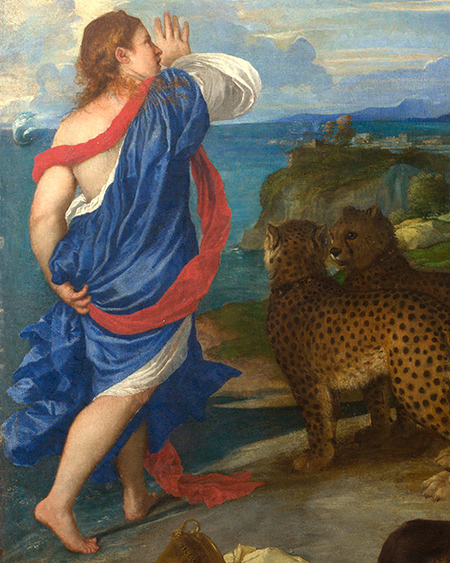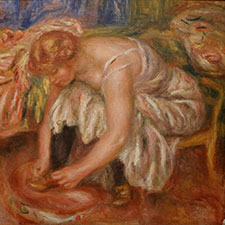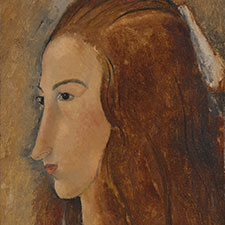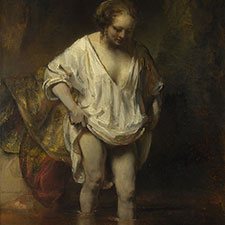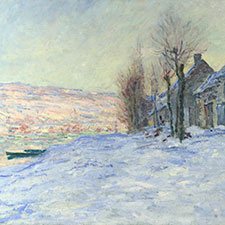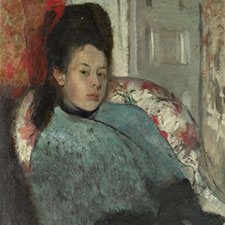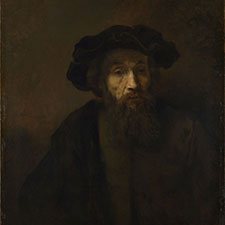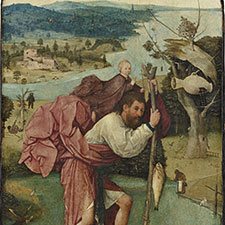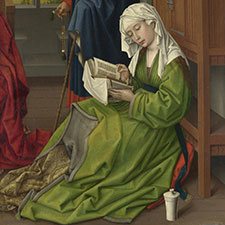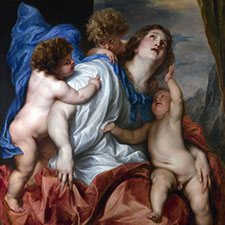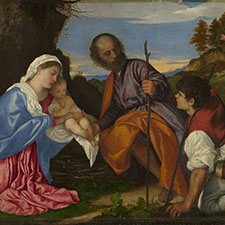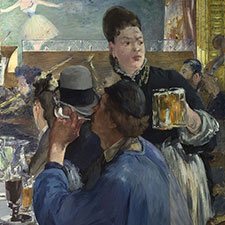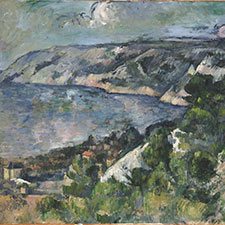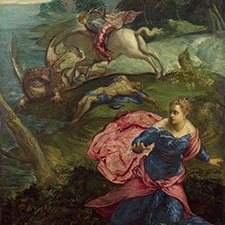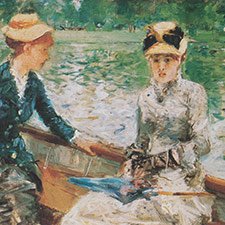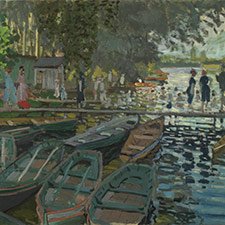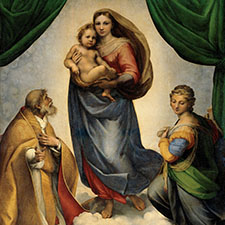Vermilion
Artificial and natural pigmentComposition and Properties of Vermilion
Vermilion (cinnabar) is mercuric sulfide with the formula HgS. The oldest form of vermilion is finely ground mineral cinnabar. Mercuric sulfide can also be produced artificially.
The pigment is not affected even by strong concentrated acids and alkalis and is considered fairly lightfast but it can darken considerably. The darkening of vermilion has been studied extensively and is due to the transformation to the black form of HgS (1,2,3). It is compatible with other pigments.
Art Teachers' Materials
Richly illustrated presentation on the properties, preparation, identification and use of this pigment

Pigment

Painted swatch
Video: Demonstrating Chinese Vermilion from Michael Harding oil paints, by Vicki Norman
References
(1) Spring, M., and Grout, R., The Blackening of Vermilion: An Analytical Study of the Process in Paintings, National Gallery Technical Bulletin, Volume 23, 2002, pp. 50-61.
(2) Chase, W.T., Feller, R.L., Gettens, R. J., Vermilion and cinnabar, in Artists’ Pigments. A Handbook of Their History and Characteristics, Vol. 2: A. Roy (Ed.) Oxford University Press 1993, p. 159 – 182. Available as pdf from the National Gallery of Art. Available as Chase, W.T., Feller, R.L., Gettens, R. J., Vermilion and cinnabar. Studies in Conservation, 17 (2), 45–69.
Names
Alternative names
Cinnabar
Zinnober
German
Vermillon
French
Color Index
PR 106, CI 77766
Vermiglio
Italian
Vermellon
Spanish
Word origin
Vermilion
Late Latin vermiculus “a little worm,” specifically, the cochineal insect from which crimson dyes were obtained, in classical Latin, “larva of an insect, grub, maggot,” diminutive of vermis “worm”.
From WordFinder
Cinnabar
“The word most likely comes from the ancient Greek κιννάβαρι kinnabari, later romanized to cinnabaris. In Persian, it is known as شنگرف shangarf; in the Arabic world it appears as زنجفرة zinjifrah.”
From: Ellen Spindler, The Story of Cinnabar and Vermilion (HgS) at The Met, Metropolitan Museum of Art, 28 Feb 2018
Alternative names
Cinnabar
Color Index
PR 106, CI 77766
Word origin
Vermilion
Late Latin vermiculus “a little worm,” specifically, the cochineal insect from which crimson dyes were obtained, in classical Latin, “larva of an insect, grub, maggot,” diminutive of vermis “worm”.
From WordFinder
Cinnabar
“The word most likely comes from the ancient Greek κιννάβαρι kinnabari, later romanized to cinnabaris. In Persian, it is known as شنگرف shangarf; in the Arabic world it appears as زنجفرة zinjifrah.”
From: Ellen Spindler, The Story of Cinnabar and Vermilion (HgS) at The Met, Metropolitan Museum of Art, 28 Feb 2018
Zinnober
German
Vermillon
French
Vermiglio
Italian
Vermellon
Spanish
Preparation of Vermilion
The mineral has to be broken, ground and purified until the color is right.
Dry process
Mercury reacts readily with molten sulfur under the formation of the black form of mercury (II)-sulfide. This form can be transformed into the red form by sublimation.
Wet process
The German chemist Gottfried Schulz discovered that the black form can be transformed into the red form by heating it in a solution of ammonium or potassium sulfide (2). This being a much simpler and cheaper method than the sublimation in the dry process.
References
(1) Miguel, C., Pinto, J. V., Clarke, M., & Melo, M. J., The alchemy of red mercury sulphide: The production of vermilion for medieval art. Dyes and Pigments, 102 (102), 2014, 210–217
(2) Chase, W.T., Feller, R.L., Gettens, R. J., Vermilion and cinnabar, in Artists’ Pigments. A Handbook of Their History and Characteristics, Vol. 2: A. Roy (Ed.) Oxford University Press 1993, p. 159 – 182. Available as pdf from the National Gallery of Art. Available as Chase, W.T., Feller, R.L., Gettens, R. J., Vermilion, and cinnabar. Studies in Conservation, 17 (2), 45–69.
(3) Bruquetas, Rocio; Kroustallis, Stafanos, Natural cinnabar production, commerce and use in Spain during XV-XVIII centuries: a documentary source research, in Studying Old Master Paintings: Technology and Practice. The National Gallery Technical Bulletin 30th Anniversary Conference, Postprints of the Conference (London, 16-18 September 2009), edited by M. Spring, London 2011.
(4) Stefanos Kroustallis and Rocio Bruquetas, Paint it red: vermilion manufacture in the Middle Ages, in: Hélène Dubois et al. (Ed.), Making and Transforming Art. Technology and Interpretation, Archetype London 2014.
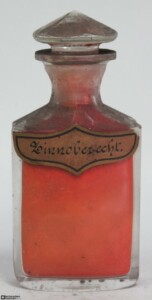
Powdered pigment
Image courtesy of Technisches Museum Wien
History of Use of Vermilion
Vermilion has been in use since antiquity until modern times. The following graph gives the frequency of its use from the 14th till the 19th century in the paintings of the Schack Collection in the Bavarian State Art Collections in Munich (1).

Examples of use
Masaccio, Saints Jerome and John the Baptist, 1428
Video: The Dazzle of Vermilion: Tracing the Early Cinnabar Trade in the Ancient Andes - Richard Burger
References
(1) Kühn, H., Die Pigmente in den Gemälden der Schack-Galerie, in: Bayerische Staatsgemäldesammlungen (Ed.) Schack-Galerie (Gemäldekataloge Bd. II), München 1969.
(2) Bruquetas, Rocio; Kroustallis, Stafanos, Natural cinnabar production, commerce and use in Spain during XV-XVIII centuries: a documentary source research, in Studying Old Master Paintings: Technology and Practice. The National Gallery Technical Bulletin 30th Anniversary Conference, Postprints of the Conference (London, 16-18 September 2009), edited by M. Spring, London 2011.
(3) Ellen Spindler, The Story of Cinnabar and Vermilion (HgS) at The Met, Metropolitan Museum of Art, 28 Feb 2018
Identification of Vermilion
Fiber Optics Reflectance Spectrum (FORS)
UV/VIS/IR spectra: US Geological Survey
Spectra by A. Cosentino, Cultural Heritage Science Open Source (CHSOS)
Infrared Spectrum
1. IR Spectrum in the ATR-FT-IR spectra of different pure inorganic pigments, University of Tartu, Estonia.

2. IR Spectrum of vermilion in linseed oil by S. Vahur, Database of ATR-IR spectra of materials related to paints and coatings, University of Tartu, Estoni
Raman Spectrum
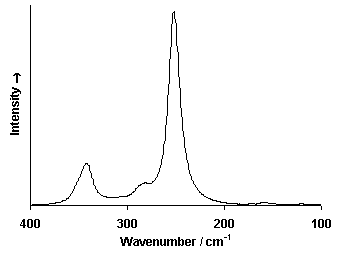
Spectrum by Ian M. Bell, Robin J.H. Clark and Peter J. Gibbs, Raman Spectroscopic Library
University College of London
X-Ray Fluorescence Spektrum (XRF)
XRF Spectrum in the Free XRF Spectroscopy Database of Pigments Checker, CHSOS website.
References
(1) Nöller, R. Cinnabar reviewed: characterization of the red pigment and its reactions, Studies in Conservation, 2014
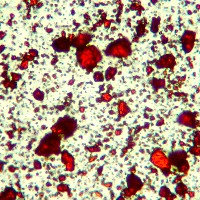
Microphotograph
image © Volker Emrath
Further Reading
References
(1) Chase, W.T., Feller, R.L., Gettens, R. J., Vermilion and cinnabar, in Artists’ Pigments. A Handbook of Their History and Characteristics, Vol. 2: A. Roy (Ed.) Oxford University Press 1993, p. 159 – 182. Available as pdf from the National Gallery of Art. Available as Chase, W.T., Feller, R.L., Gettens, R. J., Vermilion, and Cinnabar. Studies in Conservation, 17 (2), 45–69.
(2) Nöller, R. Cinnabar reviewed: characterization of the red pigment and its reactions, Studies in Conservation, 2014.
(3) Brachert, F. und T., Zinnober, Maltechnik-Restauro, 86, 1980, p.145.
(4) S. Muntwyler, J. Lipscher, HP. Schneider, Das Farbenbuch, 2nd. Ed., 2023, alataverlag Elsau, pp. 38-39.




